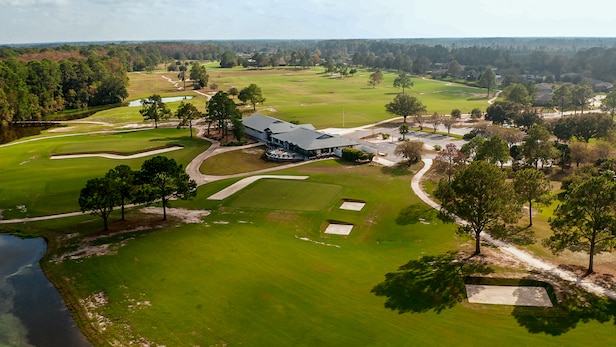
It doesn’t require extra money to build compelling architecture. No large budgets are needed to craft challenging green slopes or situate bunkers in perplexing locations. St. Johns Golf Club, a public facility near St. Augustine, Fla., proves the point.
Originally designed in the late 1980s on an often-wet potato farm two miles west of I-95, St. Johns underwent a major remodel in 2022 that transformed its holes—and its essence—from common and merely functional to imaginative, assertive and uncommon.
Ponte Vedra Beach-based architect Erik Larsen, a former longtime associate with Arnold Palmer Course Design, reimagined St. Johns as a collection of provocative greens that take inspiration from the 1910s and ‘20s and the designs of Seth Raynor and Charles Banks. The bunkers are geometrically patterned with flat sand floors and zoysia-banked grass faces stepped into the shoulders of the greens, and the fairways have been expanded to 45 to 60 yards in places to enhance playability and entice golfers to aim for better angles into the greens.
Interesting shapes alone do not make for more compelling golf. The shapes and orientation of the design features must also create interest and indecision. At St. Johns they do, beginning at the first hole, an otherwise modest par 4 where a perpendicular coffin-shaped bunker cuts off the right half of the fairway. There’s more than enough room to lay up short to leave a 140-yard approach into narrow green shaped like a worn wagon trail, but temptation exists to try to push a drive past it on the left. Most tee shots that find the bunker will have to pitch out.
The short par-5 fourth poses equally thoughtful options on the second shot due to the perpendicular orientation of the wide, shallow green. The fairway is Park Avenue wide, but long second shots must carry an edge of marsh and a deep front bunker to reach the elevated green in two, while the option of laying up to an Elysian field to the right sets up a straight-in chip or pitch along the length of the putting surface.
The impetus for the remodel was the replacement of the aging infrastructure, particularly to improve problematic drainage for both the golf holes and surrounding community, on a course that might do north of 60,000 rounds annually despite losing an average of 30 days per year to wet conditions. (At one point St. Johns was a 27-hole complex, but nine holes were shuttered in 2011, and those 80 acres of open space will be allocated for a new fire station and sheriff’s substation.) The bulk of the $8-million budget, the majority procured by St. Johns County from its general and tourist funds, went toward drainage, irrigation and new turf, which is now dry and surprisingly springy.
Larsen, working closely with longtime Director of Golf Wes Tucker, took what money was left over and put it into the crafting of the greens, the construction of several new holes and the elimination of several others. The work offers visiting and local golfers a rare taste of Raynor-Banks architecture, usually reserved for high-end private clubs like Chicago Golf Club, Fishers Island, Camargo and Shoreacres, and gives St. Johns an identity and presence it didn’t previously have.
Holes like the Biarritz par-3 second and drivable par-4 fifth, ranging from 228 to 314 yards with the choice of challenging the green (and a diagonal water hazard) straightaway, laying up or carrying a raised centerline bunker to catch a kick slope toward the putting surface, become immediate must-sees in northeast Florida public golf.
The same is true for the par-4 15th with its Punchbowl green. It’s more like a bathtub, the rectangular putting surface sunk behind an elevated front ridge so only the top of the flagstick is visible from the fairway. The side and rear slopes can be used to move balls toward center and back hole locations, but when the pin is cut forward the only way to get the ball close is to trickle a running shot over the front lip of the tub.
Other holes, like the strong par-4 third around a lake, the par-4 tenth with a centerline bunker and plateau green flanked by depressed trench bunkers, the flowing par-5 11th with bunkers staggered short of the green and the dogleg left 13th that entices you to gamble with the inside line to get a proper angle on the deep, narrow green, each embody classic architectural principles of strategy and seeking the most advantageous lines of play.
Little can be done about the flatness of the site, and there are a few places where the corridors, based on the old land plan and environmental restrictions, are a too narrow to evoke the same sense of options that exist elsewhere (the par-4 ninth and 16th). It does far more than is necessary, however, to transcend these shortcomings. Prices range from just $25 for walkers to a top rate of $59.50 for out-of-state players. The course expects to log over 70,000 rounds in 2023, showing that there can still be significant economic, social and environmental benefits when municipalities embrace golf as a public good and a protector of green space, environments and other utilities.
The new design demonstrates that interesting golf need not be expensive. At an affordable price, St. Johns does what all charismatic architecture does—it grabs your attention, makes you think, and makes you curious about what’s coming next.
"course" - Google News
August 11, 2023 at 07:44PM
https://ift.tt/PvHAIZg
A newly reopened public course in Florida shows how creative design can be affordable - GolfDigest.com
"course" - Google News
https://ift.tt/4xXQUpW
https://ift.tt/RBINfXw
Bagikan Berita Ini














0 Response to "A newly reopened public course in Florida shows how creative design can be affordable - GolfDigest.com"
Post a Comment